Physics links
For the experts
Notes
Research and physics interests
![]()
As I said, I am a postdoc in theoretical physics, high-energy
theoretical physics to be more precise. My main interests are in supergravity
and string theory. Well, since not everybody is an expert (...), let me explain
a bit what that means. For the experts, I will give below a more precise
description of my research. So:
![]()
- What is string theory and why are we (physicists) interested in it?
- I will try to give a flavour of that in a few lines. OK, maybe not
- that few, but if you get bored skip this paragraph.
*
- String theory is, simply put, an attempt to unify all the fundamental
- particles in Nature. In other words, particles and forces which seem
- to us to be different (because of their different properties, and different
- theories needed to explain each one of them) are, in string theory,
- fundamentally the same.
- Why do we feel we need to find such a
- unified theory? Well, unification has been a rule that governed the
- history of physics. Maybe the first one is the idea of the atom, which
- ancient Greeks had already. That is, that all the different substances
- we see are composed of a few different types of atoms, combined in
- various ways. But then we found that the atom is not fundamental,
- and is composed of a dense nucleus and electrons orbiting around it.
- The nucleus itself is made out of protons and neutrons, and different
- atoms are just composed of different numbers of protons, neutrons
- and electrons. In the 70's, we found that the protons and neutrons are
- not fundamental either, but are each composed of 3 subunits called quarks.
- So: nowadays, we have a description of the known physics in terms of
- a theory of quarks, electrons, a few other exotic particles similar to the
- electron (called leptons), and the forces between them, described by particles
- called gauge bosons (photons, gluons, W and Z). All of these are described in
- the framework of what is generically called quantum field theory (QFT).
- In QFT, each force corresponds to a particle (for example, the electro-
- magnetic force corresponds to the photon).
- But we have also gravity, which cannot be described consistently within
- this framework. And that is considered by most theorists to be a problem.
- One of the most important discoveries of Einstein was General Relativity,
- which states that gravity is nothing else than the curvature of spacetime.
- In string theory, the framework of quantum field theory is slightly modified,
- and gravity is described together with the other particles and forces between them.


*
- So, what is the main message of string theory? That all the known
- fundamental building blocks of Nature (quarks, leptons and gauge bosons),
- together with lots of others not discovered yet, but predicted by the theory,
- are really not point particles, but very tiny string-like objects, oscillating
- very rapidly.The length scale of this strings is so unbelievably small
- that we might never be able to probe it (observe it directly in an experiment).
- And the fact that we see different kinds of particles is due to the fact that the
- strings vibrate differently (different modes of oscillation of a string corres-
- pond to different particles).
- A characteristic of string theory is that its consistency requires the
- presence of 7 extra dimensions, besides our 4 (3 space and one time).
- This extra dimensions are unobservable because they are also
- unbelievably tiny, in fact not much more than the size of the string itself.
- In the last few years, string theory has become not only a theory of strings, but
- rather also of membrane-like objects, or even objects extended in more than 2
- spatial dimensions (remember that we have a total of 11 dimensions), called
- p-branes (by a weird linguistical extension of the word mem-brane).


*
- And then there's supergravity. What is supergravity? Another attempt to unify
- gravity with the other interactions within QFT. It is a more conventional
- (conservative) approach, and is now generally believed to be inconsistent on its
- own. But it can be viewed as a special limit of string theory (it applies for
- distance scales which are not too small - bigger than the string theory length scale).
*
![]()
My research:
The AdS-CFT correspondence (started by Juan
Maldacena, 1997, in hep-th/9711200)
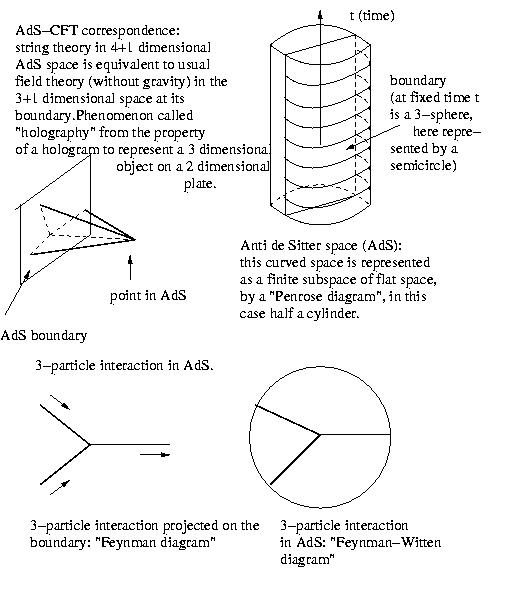
SYM- pp waves correspondence
(started by David Berenstein, Juan Maldacena and
myself in 2002, in hep-th/0202021)
The AdS-CFT correspondence relates really only supergravity (the low
energy limit of string theory) with field theory. The SYM-pp waves
correspondence relates the full string theory on pp waves with
the field theory on the boundary, but only for a subset of
observables.
PP waves (paralel plane waves) are gravitational waves, that is
disturbances in the gravitational field (i.e.curvature of spacetime)
propagating at the speed of light.
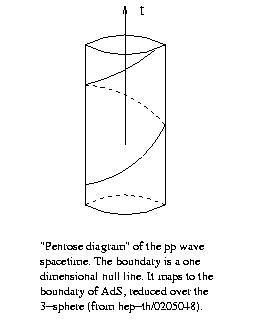
Matrix theory
realization of M theory
(started by Banks, Fischler, Shenker and Susskind
in 1996, in hep-th/9610043)
Matrix theory is a particular realization of M theory, which itself is an
extension
of string theory, valid when the string theory approximation breaks down. I am
working on applying Matrix theory to the SYM-pp wave correspondence, to
cosmology (the origin and evolution of the Universe), among other things.
The basic idea of Matrix theory is that the notion of spacetime is not a
fundamental
concept, but a derived one. The basic objects of Matrix theory are
particle-like objects,
called "D0 branes", and when there are sufficiently many (N large) of
them you can talk
about an approximate spacetime description in which the N D0 branes are almost
characterized by N positions, but in reality there are N^2 (N times N)
position-like
variables ("N by N matrices").
We can get a image of this strange behaviour by mentally separating a few (in
the drawing
below 3) D0 branes frome the N, and let the other N-3 create an approximate
spacetime
background. Then, by including the relative separations of the particles (which
normally
are not independent variables, only the absolute positions are), and also
saying that, e.g.,
the distance between 1 and 2 is not the same as the distance between 2 and 1,
we get
3^2=9 variables.
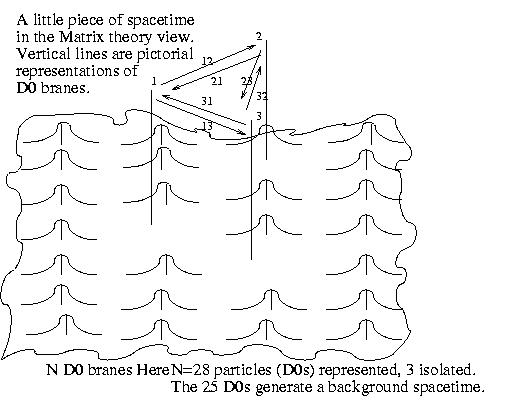
![]()
Experimental consequences for string theory via AdS-CFT:
high energy QCD scattering and the RHIC fireball
(with K. Kang and by myself, 2004-2005)
AdS-CFT relates general field theories (without gravity) in our 3+1 dimensions
to gravitational theories (string theory) in an abstract curved 10 dimensional
space.
Most phenomena depend on the 10d space 4+1 dimensional part, which is of
Anti de Sitter (AdS) type. The field theory models for which the
relation ("duality") is
well understood are highly symmetric (Conformal Field Theories, or CFT), and it
was
not clear whether anything can be said for the dual of strong interactions
(Quantum
ChromoDynamics, or QCD).
I have proposed that we can use a very simple model, AdS space that ends at a
"wall", as a dual of QCD. Then scattering (colliding) at high
energies particles
that interact via strong interactions is mapped to collisions in the dual
(abstract)
space, where particles are "spread out" over the 5th dimension,
but the interaction
is concentrated in a small region near the wall. The strong force that governs
the
real interactions is mapped to the gravitational force in the dual description
(abstract AdS space). Thus at high enough energies one produces black holes
(the ultimate effect of gravitational collisions) in AdS.
Initially, the created black holes are small enough, so they don't feel the
curvature
of AdS. As one increases the collision energy, the black holes get bigger, and
they
"feel" the curvature of AdS, and as they get even bigger they reach
the "wall" at the
end of AdS, and get stuck there. Then the dual (AdS) description is
effectively
4 dimensional (as the extra coordinates are "frozen"), and thus one
describes
scattering in the real 4dimensional world, that is governed by strong
interactions,
via scattering in an abstract 4d world (coming from the abstract AdS space),
governed by gravitational interactions.

A simple description of the 3+1 dimensional collision (in our real world) in
terms
of an effective QCD field is given below. At high enough energies (for
velocities
close to the speed of light), particles get "squashed" due to
relativistic effects
("Lorentz contraction"), thus a spherical object will look as a
pancake. If the
colliding particles are close enough, they will form a QCD analogue of a
black hole, i.e. the fireball that is observed at RHIC (Relativistic Heavy Ion
Collider,
at Brookhaven).

The dual description of the collision is in terms of effectively 4 dimensional
collisions
governed by gravity, in which black holes are formed and decay, by thermal
emission
of particles. However this 4 dimensional gravity is not of the usual type, but
the graviton
has a mass, which means that gravity travels slower than the speed of light and
has a
finite range, governed by the graviton mass.
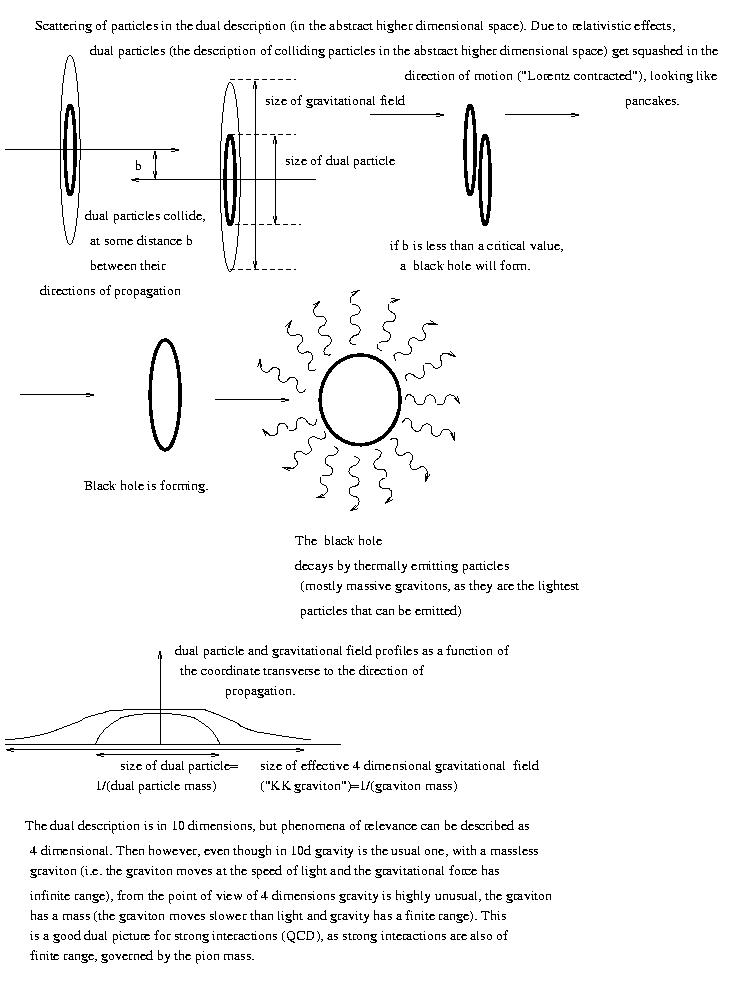
For completeness, a simple description of the usual 4 dimensional
(Schwarzschild)
black holes: They are characterized by two objects: the singularity at its
center
and the event horizon at some distance from it. An infalling observer notices
nothing
at the horizon, but gravity (tidal forces pulling him apart) become infinitely
strong
at the singularity in the center. From the point of view of an outside
observer, the
"time dilation effect" increases (time passes slower near the black
hole)and becomes
infinite at the horizon (objects are "frozen in time"),
and the horizon is also the
place that emits particles thermally.
The dual black hole will still have an event horizon, but it is not clear that
it will
have a singularity.
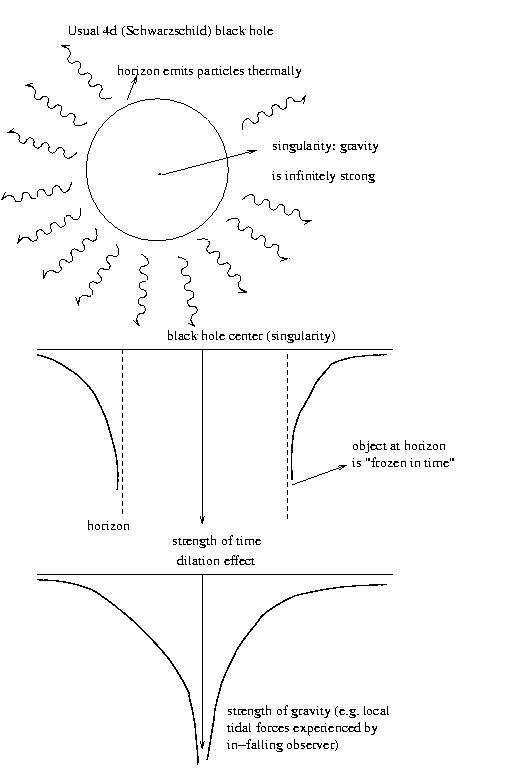
![]()
Notes (in logical order):
Susy, sugra, strings, branes, duality (6 pages)
Supersymmetry in 4d (14 pages)
Duality (21 pages)
Seiberg-Witten theory (12 pages)
Supergravity (37 pages)
Hamiltonian quantization and BRST (17 pages)
Integrable systems, application to N=4 SYM (42 pages)
![]()
Lecture notes
![]()
Online talks
-At
-PP waves (Mar
05, 2002)
-Black holes and
QCD (Feb 25, 2005)
-At Rutgers University:
-Black holes
and QCD (Mar 8, 2005)
-at
the Newton Institute in
-High
energy QCD collisions at RHIC and the LHC from dual black hole
![]()
For the experts:
My research covers a
wide range of subjects in string theory and supergravity:
Gauge-string theory
dualities, nonperturbative phenomena, matrix models,
noncommutative geometry,
particle phenomenology, cosmology, as well as the
nonperturbative
definition of string theory in various backgrounds (AdS, plane waves,
M theory
alternatives) and of supergravity compactifications.
Current interests
include experimental consequences of string theory for high
energy QCD
scattering via AdS-CFT, the definition of string interactions and holography in
plane waves, a possible
new M theory definition, braneworld phenomenology,
string cosmology,
Matrix models compactifications.
The main emphasis is on
the AdS-CFT correspondence and gauge-string theory
dualities. Recently, in
the paper
Strings in flat space
and pp-waves from N=4 Super Yang-Mills, with
David Berenstein and
Juan Maldacena, and then in the follow-ups
Open strings on plane
waves and their Yang-Mills duals,
with David Berenstein,
Edi Gava, Juan Maldacena and K.S. Narain and
On lightcone string
field theory from Super Yang-Mills and holography,
with David
Berenstein,
I have put the
foundation of a relation between string theory and gauge
theory going beyond the
usual AdS-CFT (which involves only gravity, not the full string
theory). It has
generated significant amount of work since then (almost 700 papers to date).
My latest work tries to
derive features of high energy scattering in QCD from AdS-CFT.
In the papers (with Kyungsik Kang)
High energy QCD from Planckian scattering in AdS and the Froissart bound and
Heisenberg
saturation of the Froissart bound from AdS-CFT
I have showed
that one can obtain the Froissart bound saturation from AdS-CFT, in
The soft Pomeron
from AdS-CFT
I showed that the
"soft Pomeron" behaviour of the total QCD cross section can be
derived from AdS-CFT, and in
The RHIC fireball as a dual black hole
I have showed that one can describe the fireball observed at RHIC as a dual
black hole,
in terms of an effective (KK reduced) massive gravity in 4d.
I have tried to bring AdS holography to the level of the Standard Model, and
study possible
implications for
phenomenology and string model building in
On Dp-Dp+4 systems,
QCD dual and phenomenology.
The study of systems
with lower (N=1 in n3d) supersymmetry and of dynamical supersymmetry
breaking in the context
of gravity-gauge duality was realized in
The supergravity dual
of a theory with dynamical supersymmetry breaking,
with Juan Maldacena.
I am trying to define M
theory as a Chern-Simons theory, by studying the possible
use of CS supergravity
in phenomenology. The first step was taken in the paper
Towards a
Chern-Simons M theory of OSp(1|32) X OSp(1|32)
Matrix model
compactifications and a link to noncommutative geometry was studied in
Massive IIA
string theory and Matrix model compactification
with David Lowe and
Sanjaye Ramgoolam.
I am also trying to
prove nonperturbatively the AdS-CFT correspondence. In the paper
A new AdS-CFT correspondence, with Warren Siegel,
I described a discretization of the string action in AdS space which provides a link
to Yang Mills theories in 4d.
An important part of my work was the study of consistent truncations, and the
proof that the AdS(7) times S(4) KK reduction admits a consistent truncation.
The ref. for that is
Consistency of the AdS(7) times S(4) reduction and the
origin of self-duality in odd dimensions, with Diana Vaman
and Peter van Nieuwenhuizen.
I also wrote a paper on the quantization of solitons. As a first step towards
understanding more difficult systems, like D-branes, I studied the simplest
solitons, namely in two dimensional field theories.
Ref (see the link below to the
Topological boundary conditions, the BPS bound,and
elimination of ambiguities in the quantum mass of
solitons. , with Misha Stephanov, Peter van Nieuwenhuizen (my
advisor), and Anton Rebhan.
I co-authored one of the first papers to find concrete evidence for the
AdS-CFT correspondence, by a calculation of 3-point correlators
in SYM and in AdS space.
The Ref. is
R-current correlators in N=4 SuperYang-Mills theory from
Anti-de Sitter supergravity, with Gordon Chalmers, Ruud Siebelink
and Koenraad Schalm.
Here is a link to a complete list of my papers.
and a citation summary of my papers.
And here is my proffesional CV
![]()
![]() So we now study branes and strings,
which gives a few unavoidable confusions:
So we now study branes and strings,
which gives a few unavoidable confusions:
if you go to a conference and are lost, and ask somebody about the place where
the conference on branes and strings is, he will first think what is the connection
between the brains and musical intruments? In fact, I don't know wether somebody
had a joking mind or it was a coincidence, but the Strings'98 conference in
conference in
other use of the term strings...
![]()
Physics links
![]()
This page created with Netscape Navigator Gold